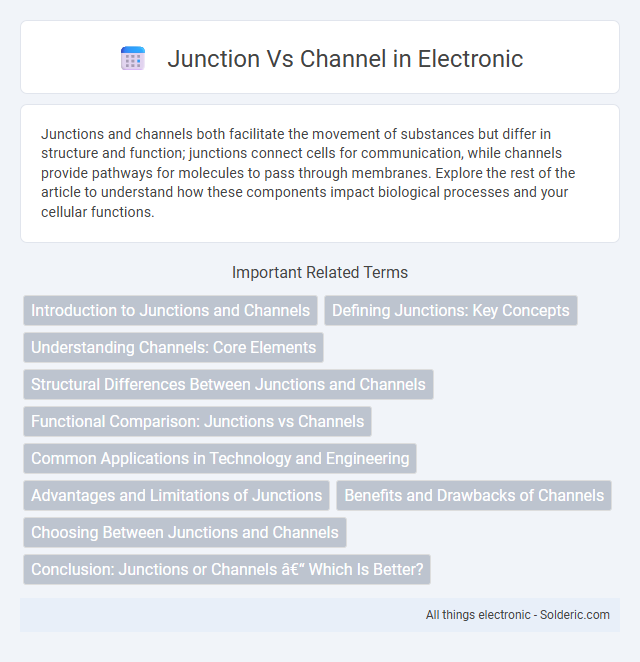Junctions and channels both facilitate the movement of substances but differ in structure and function; junctions connect cells for communication, while channels provide pathways for molecules to pass through membranes. Explore the rest of the article to understand how these components impact biological processes and your cellular functions.
Comparison Table
| Feature | Junction | Channel |
|---|---|---|
| Definition | Central point connecting multiple lines or routes | Pathway or medium allowing data or fluid flow |
| Primary Use | Structural intersection in networks or transport | Conduit for communication, data, or liquids |
| Example Contexts | Road junctions, railway junctions, electrical circuits | Telecommunication channels, water channels, data channels |
| Function | Connects and manages flow between paths | Transmits signals, data, or materials along a set route |
| Typical Forms | Intersections, crosspoints, nodes | Pipes, cables, waveguides |
| Semantic Keywords | Connection, intersection, node, convergence | Transmission, conduit, medium, pathway |
Introduction to Junctions and Channels
Junctions and channels are crucial components in semiconductor devices that control the flow of electric current. A junction typically forms where two different semiconductor materials, such as p-type and n-type, meet, creating a depletion region that regulates charge carrier movement. Channels, on the other hand, are conductive paths within a semiconductor that allow current flow between two terminals when an appropriate voltage is applied, playing a vital role in devices like transistors.
Defining Junctions: Key Concepts
Junctions are critical points where multiple channels converge or diverge, facilitating fluid flow or electrical current in systems like hydrology or circuit design. Understanding the geometry, flow dynamics, and connectivity of junctions is essential for optimizing system efficiency and performance. Your ability to analyze these key concepts determines effective management and troubleshooting in networked environments.
Understanding Channels: Core Elements
Channels consist of key components including the physical medium, signal propagation method, and bandwidth capacity, which collectively determine data transmission efficiency. Understanding how factors like noise, interference, and attenuation impact channel quality is essential for optimizing communication systems. Channel models such as wired, wireless, and optical provide frameworks to analyze performance and design robust networking solutions.
Structural Differences Between Junctions and Channels
Junctions are specialized structures where two membranes closely appose to create a continuous barrier or controlled communication point, often involving adhesive proteins or tight seals, while channels are protein complexes forming pores that allow selective ion or molecule passage across membranes. The structural organization of junctions typically includes multiple adhesion molecules forming a dense, intercellular network, whereas channels consist of transmembrane proteins with central pores enabling direct cytoplasmic exchange. Understanding these differences is crucial for your research on cellular connectivity and transport mechanisms.
Functional Comparison: Junctions vs Channels
Junctions, such as tight junctions, serve primarily to create barriers that control the passage of substances between cells, maintaining distinct cellular environments. Channels, like gap junctions or ion channels, enable direct communication and the selective exchange of ions and small molecules between adjacent cells, facilitating rapid signal transmission. Both structures are essential for tissue integrity and intercellular communication, but junctions emphasize barrier function while channels prioritize connectivity and molecular exchange.
Common Applications in Technology and Engineering
Junctions find extensive use in semiconductor devices like diodes and transistors, where they control the flow of electrical current by forming p-n junctions. Channels are fundamental in field-effect transistors (FETs), acting as conductive pathways that allow current to flow between the source and drain terminals under gate voltage control. Understanding the distinct roles of junctions and channels is essential for optimizing the performance of electronic circuits and designing advanced integrated systems.
Advantages and Limitations of Junctions
Junctions provide efficient control over current flow in electronic circuits by enabling precise switching and amplification, making them ideal for applications like transistors and diodes. Their advantages include low power consumption, high-speed operation, and compact size, which support enhanced circuit performance. Limitations involve sensitivity to temperature variations and potential leakage currents, which can affect stability and overall reliability in certain conditions.
Benefits and Drawbacks of Channels
Channels offer streamlined communication and organized message flow, making it easier for teams to collaborate efficiently by grouping related conversations in one place. However, channels can become overwhelming if poorly managed, leading to information overload or missed important updates due to high message volume. You must weigh these benefits and drawbacks when deciding if channels suit your team's communication style.
Choosing Between Junctions and Channels
Choosing between junctions and channels depends on specific network design requirements, such as data flow control, scalability, and fault tolerance. Junctions provide centralized management for connecting multiple network segments, optimizing traffic routing and reducing latency. Channels support direct, streamlined communication between devices, ideal for high-speed data transfer with minimal overhead.
Conclusion: Junctions or Channels – Which Is Better?
Junctions provide direct access paths with minimal latency, ideal for high-speed data transmission, while channels offer managed communication routes that enhance reliability and traffic control. Your choice depends on whether your priority is maximizing speed or ensuring stable, organized data flow within a network. Understanding the specific requirements of your system will help determine if junctions or channels are better suited for your application.
Junction vs Channel Infographic

 solderic.com
solderic.com